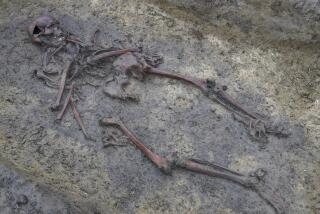Skulls Telling Tales of Ancient Mariners : Sweden: Skeletons from a 1628 shipwreck give a glimpse of how the sailors looked and lived. Hollywood’s portrayals turn out to be pretty accurate.
- Share via
STOCKHOLM, Sweden — Hollywood’s stereotypes of old-time sailors as scar-faced, crippled and toothless come close to reality, according to a Swedish scientist who is studying the remains of 17th-Century seamen.
Bone specialist Ebba During spent four years scrutinizing the bones of sailors who died in 1628 when the Vasa, headed for the Thirty Years War on its maiden voyage, sank in Stockholm harbor.
Presenting her findings at the museum where the raised wreck now rests, During said that about a third of the 25 crewmen she studied had broken at least one bone and many had had teeth pulled or knocked out.
“This was a handsome man . . . very manly, with his square eye sockets and powerful chin,” she said, holding up a skull.
But, she said, “he’s been hit here and his nose has been broken, perhaps in a bar fight.” She pointed to a mark between the eye sockets.
The Vasa was built to be the pride of King Gustav II Adolphus’ fleet in his campaigns on the European Continent. The 200-foot warship had a crew of about 400, including 300 soldiers, and was equipped with 64 guns.
Unfortunately, however, the ship was unstable. It capsized about 1,000 yards from the dock.
The accident shocked the nation.
“It can be compared to the Challenger disaster. It was probably just as horrible for the people watching,” said During, referring to the U.S. space shuttle that exploded after launching in 1986.
After 333 years at the bottom of the harbor, the Vasa was salvaged in 1961 and the remains of the crewmen, ages 13 to 60, were buried.
During, an osteologist at Stockholm University, had the graves opened in 1989. What was left of the crew was a collection of tobacco-colored bones and skulls.
She was unable to identify the men, so she invented a name for each group of pieces that came from the same individual.
She put together two reasonably complete skeletons, but in most cases she had only a few parts to work with. The only part remaining of a man she called “Niklas” was one wisdom tooth.
The Vasa was headed through the Stockholm archipelago and was due to sail southward, across the Baltic, after letting off wives and girlfriends at Vaxholm, a port outside Stockholm. The women had been allowed aboard for the first part of the trip.
One of them was “Beata,” a woman about 20 years old who stood about 5 feet 4. During found 51 pieces of her skeleton.
“As a child, she was sick several times,” During said, pointing out stains on the teeth that indicated they had stopped growing because the body was battling a disease. During said she was also prone to diarrhea because of chronic malnutrition.
A pilot, “Filip,” had a lesion on his elbow that showed he had worked too hard at the tiller as a young boy.
“It is one of the earliest documented occupational injuries,” During said.
Although the Vasa crew members were damaged, During said the navy “probably looked for people in relatively good health. I wouldn’t be surprised if these people were in better shape than the average.”
She published her report in a 160-page book, “They Died Aboard the Vasa.”
The skeletons have more to tell, she said. In the next phase of her research, she plans to analyze the bones via DNA techniques. The skulls of Beata and a younger woman have similar shapes.
“With a DNA analysis, we could answer the question of whether the ladies are sisters or related in some other way,” During said.
More to Read
Sign up for Essential California
The most important California stories and recommendations in your inbox every morning.
You may occasionally receive promotional content from the Los Angeles Times.










